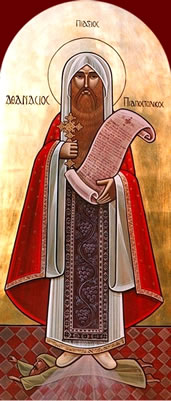Philostorgius’ record of those who sympathized with Arius I
| Date | c. 425 – Philostorgius c. 860 – Photius |
| Ancient source | Photius’ Summary of Philostorgius’s Church History 1.8-10 |
| Modern edition used | F. Winkelmann (post J. Bidez), Philostorgius. Kirchengeschichte, 3rd edn. Die griechischen christlichen Schriftsteller (Berlin: Akademie Verlag, 1981), p. 9-10. English translation: Philip R. Amidon (2007) Atlanta: Society of Biblical Literature. |
| Note | Basil of Amasea, listed below, was martyred in 312, according to Ernst Honigmann.* This fact leads Parvis to conclude that this list was originally a list of those who “had some theological sympathy with Arius prior to late 324” but that either Philostorgius or Nicetas associated it with Nicaea years after it was composed (p. 45).* Ernst Honigmann, Patristic Studies, Studi e Testi 173 [Vatican City: Biblioteca Apostolica Vaticana, 1953], pp. 14-27, cited in Parvis, p. 44 note 28. |
(8.) Shortly afterwards, the Council of Nicaea was held, at which bishop Basil of Amasea [see note above] and Melitius of Sebastopolis were present among the other high priests of God.
(9.) Philostorgius also relates that all the bishops consented to the definition of the faith produced at Nicaea, with the exception of Secundus, bishop of Ptolemais, whom Theonas, bishop of Marmarice followed. But the rest of the group of Arian bishops, such as Eusebius of Nicomedia (whom Philostorgius deifies as The Great), Theognis of Nicaea, and Maris of Chalcedon, and the rest of the array changed their battle-plan for the council, though deceitfully (as Philostorgius admits), for concealed homoiousios under homoousios*, though indeed they submitted to the council’s decision, when Constantina, the emperor’s sister, gave them this advice.
(10.) Philostorgius adds that Secundus, on going into exile, said to Eusebius, “You subscribed, Eusebius, in order to escape being sent into banishment. But I place my confidence in a revelation made to me by God, that within a year you too will be sent into exile.” In fact, within three months after the conclusion of the council, returning to his own original and manifest impiety, Eusebius was sent into exile as Secundus had predicted.
translation from Edward Walford, trans., The Ecclesiastical History of Sozomen… Also: The Ecclesiastical Eistory of Philostorgius, as Epitomised by Photius, Patriarch of Constantinople (London: Henry G. Bohn, 1855), pp. 443-44, available online, adapted by AJW.
*.see the 2007 English translation: Philostorgius: Church History, ed. and trans. Philip R. Amidon (Atlanta: Society of Biblical Literature), p. 11, note 19.
References for Map of Early Arian Supporters:
| Philostorgius I | Philostorgius II | Theodoret | Arius’ letter |
Translation and introduction by AJW
No Responses yet
